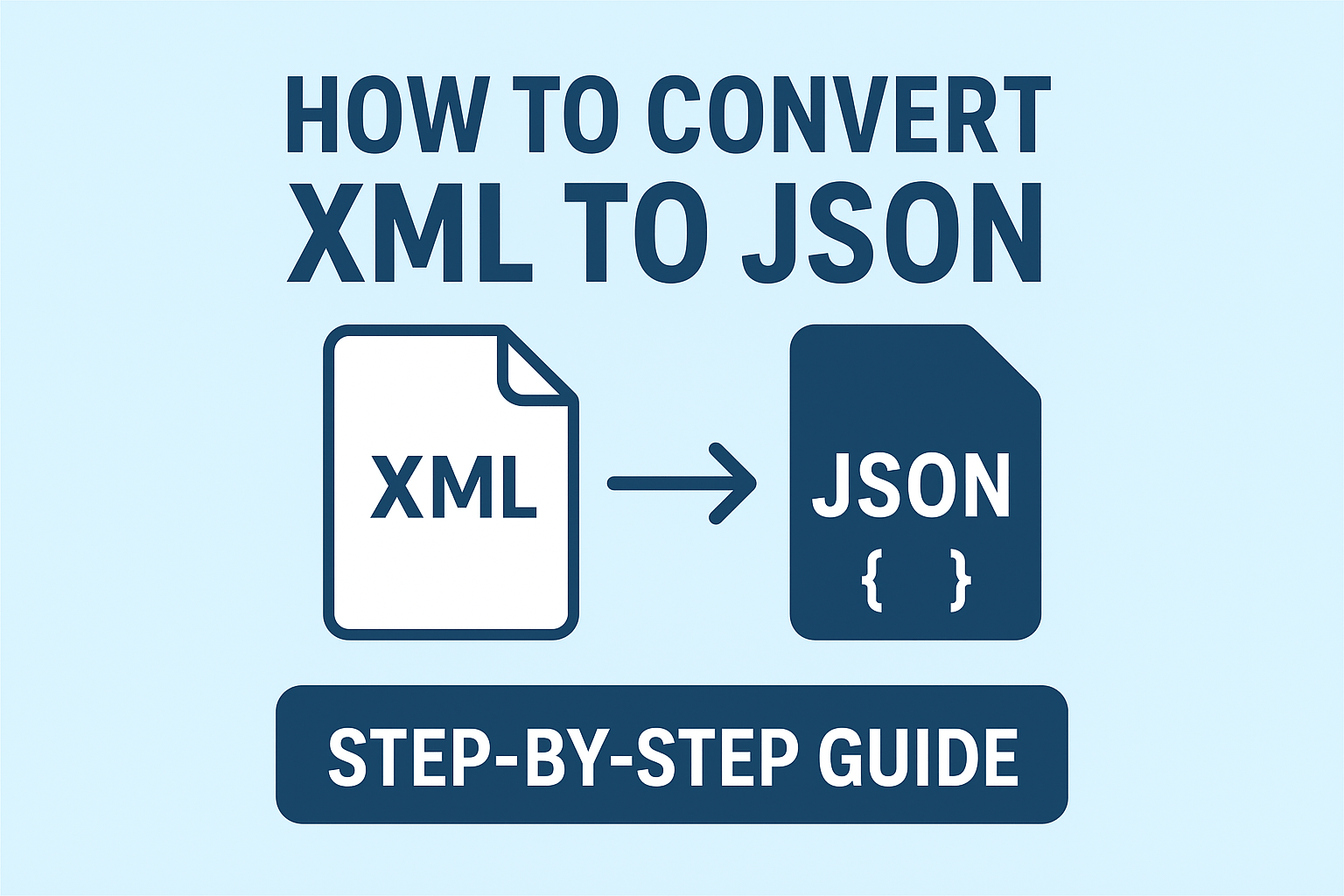Introduction
Two popular formats used for sharing and storing this data are XML and JSON. While XML has been around for a long time, JSON has become the preferred choice because it’s faster, lighter, and easier to read. Many developers and website owners now need to convert XML to JSON to keep up with modern tools and technologies.
If you’ve ever opened an XML file and felt confused by all the tags, don’t worry, you’re not alone. The good news is that converting XML to JSON is straightforward and quick when you know the process. In this article, we’ll explain what XML and JSON are, why conversion matters, and how to convert XML to JSON easily using online tools or code examples in Python and JavaScript.
What Is XML?
XML (Extensible Markup Language) is a format that stores data in tags, much like HTML. It looks like this:
| <person> <name>John</name> <age>30</age> </person> |
XML is well-suited for structured data, but it can be more challenging to read and longer than JSON.
What Is JSON?
JSON (JavaScript Object Notation) is a format that stores data in a more straightforward way using key-value pairs. It’s popular in APIs and modern apps.
Here’s the same data in JSON:
| { “person”: { “name”: “John”, “age”: 30 } } |
As you can see, JSON is clean, short, and easy to understand.
XML vs JSON:
| Feature | XML | JSON |
| Format | Uses Tags | Uses Key-Value Pairs |
| Readability | Harder | Easier |
| File Size | Larger | Smaller |
| Speed | Slower | Faster |
| Common Use | Document | APIs & Web Apps |
Why Convert XML to JSON?
Here are some simple reasons why people convert XML to JSON:
- Faster data processing
- Easier integration with websites and apps
- Better readability for humans
- Lightweight files, which means faster load times
- Works excellently with JavaScript and APIs
Methods to Convert XML to JSON
There are a few easy ways to do this, even if you’re not a programmer.
1. Use an Online XML to JSON Converter
This is the simplest way.
You can use a free tool like Rapid Free Formatter.
Steps:
- Go to an online converter website
- Paste your XML code
- Click “Convert to JSON”
- Copy or download your new JSON file
That’s it! No coding needed.
2. Convert XML to JSON in JavaScript
If you’re coding, JavaScript has libraries that make it simple.
Example:
| const xml2js = require(‘xml2js’); const parser = new xml2js.Parser(); const xml = ‘<person><name>John</name><age>30</age></person>’; parser.parseString(xml, (err, result) => { console.log(JSON.stringify(result)); }); |
This code reads your XML and changes it into JSON instantly.
3. Convert XML to JSON in Python
Python also has an easy way to do it using the xmltodict library.
Example:
| import xmltodict import json xml_data = “<person><name>John</name><age>30</age></person>” json_data = json.dumps(xmltodict.parse(xml_data)) print(json_data) |
This gives you clean and readable JSON output.
Best XML to JSON Converters (2025)
Here are the trusted tool you can use for free:
RapidFreeFormatter.com is one of the top online tools for developers and data analysts who require quick and accurate conversions. It lets you convert XML to JSON, format code, and beautify text in just seconds, all for free.
The site is fast, easy to use, and doesn’t require any sign-up or software installation. Whether you’re working on web development, API testing, or data formatting, RapidFreeFormatter.com saves time and ensures clean, readable output. Its simple design, instant results, and wide range of data conversion tools make it the top choice for both beginners and professionals.
Common Conversion Problems
Sometimes, you may encounter minor issues during the conversion process. Here’s how to fix them:
- Nested Tags: Verify that your XML tags are properly closed.
- Attributes missing: Ensure you use the correct converter that preserves XML attributes.
- Encoding errors: Use UTF-8 encoding to avoid character issues.
SEO Tip for Developers
If you work with websites, you can also convert XML sitemaps to JSON. This helps when you want to show your site’s data in a web app or dashboard in a cleaner way.
Conclusion
Converting XML to JSON is no longer a complex task. With modern tools and a basic understanding of both formats, anyone can do it in minutes. JSON is now the standard format for web and app development because it’s simple, lightweight, and easy to process. Whether you’re working with APIs, databases, or website data, using JSON can make your projects run faster and smoother.
If you don’t want to write code, you can use free online tools like RapidFreeFormatter.com, which lets you convert XML to JSON instantly without installing anything. It’s perfect for beginners and professionals alike.
So next time you’re dealing with an XML file, don’t stress just convert it to JSON and enjoy a cleaner, faster, and more readable format. Data conversion doesn’t have to be hard when the right tools make it this easy!
FAQs:
1. Can I convert XML to JSON online?
Yes! Use free tools like RapidFreeFormatter.
2. Will conversion change my data?
No, but you should check for missing attributes after converting.
3. Is JSON better than XML?
Yes, for most web apps and APIs — it’s faster and easier to read.
4. Do I need coding to convert XML to JSON?
Not at all. Online tools can do it instantly for you.

